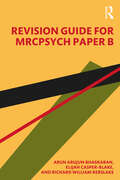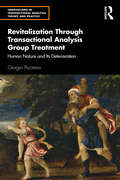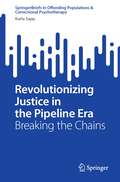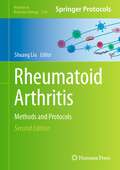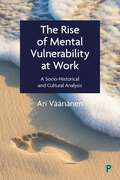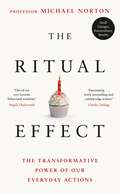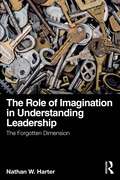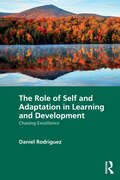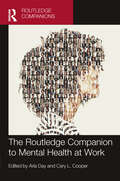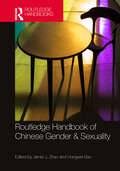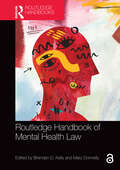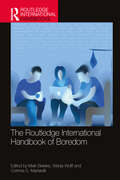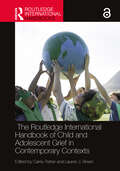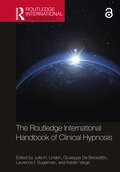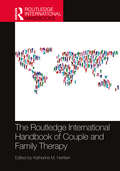- Table View
- List View
Revision Guide for MRCPsych Paper B
by Arun Bhaskaran Elijah Casper-Blake Richard William KerslakeThis text covers the key information necessary to pass Paper B of the postgraduate examination and become a member of the Royal College of Psychiatrists (MRCPsych).It provides candidates with comprehensive coverage of the Paper B syllabus, including information from a wide variety of sources to save candidates crucial time during exam revision. The content is accessible and presented in manageable sections, highlighting key information using tables, lists and graphics.This text is essential for psychiatry trainees revising for their written examinations and is also suitable for individuals/healthcare professionals with an interest in psychiatry and a desire to learn more.
Revitalization Through Transactional Analysis Group Treatment: Human Nature and Its Deterioration (Innovations in Transactional Analysis: Theory and Practice)
by Giorgio PiccininoThis innovative book describes the original essence particular to the human species and details the steps necessary to help re-establish this essence, in cases when it has deteriorated, in a therapeutic group context of solidarity and closeness. Disappointment in primary relationships particularly triggers the deterioration of self-offering, an initially expansive and trusting disposition to affectivity and love. People suffer when, like any fragile and delicate living being early in life, they fail to evolve according to the nature of their species. Therapeutic work is therefore described as mainly oriented to reactivate in a group, a new welcoming family, the original natural drives with new permissions, new trials and new joyful experiences. The book contains the methods and techniques routinely used by the author and two case studies, faithfully transcribed and commented on, particularly for the reactivation of the affective drive. Revitatlization Through Transactional Analysis Group Treatment is an insightful addition to the literature for transactional analysts in practice and in training, for professionals interested in the theory and practice of transactional analysis. Piccinino writes in a compelling manner allowing for the content to be accessible to anyone seeking to understand human processes and wellbeing.
Revitalization Through Transactional Analysis Group Treatment: Human Nature and Its Deterioration (Innovations in Transactional Analysis: Theory and Practice)
by Giorgio PiccininoThis innovative book describes the original essence particular to the human species and details the steps necessary to help re-establish this essence, in cases when it has deteriorated, in a therapeutic group context of solidarity and closeness. Disappointment in primary relationships particularly triggers the deterioration of self-offering, an initially expansive and trusting disposition to affectivity and love. People suffer when, like any fragile and delicate living being early in life, they fail to evolve according to the nature of their species. Therapeutic work is therefore described as mainly oriented to reactivate in a group, a new welcoming family, the original natural drives with new permissions, new trials and new joyful experiences. The book contains the methods and techniques routinely used by the author and two case studies, faithfully transcribed and commented on, particularly for the reactivation of the affective drive. Revitatlization Through Transactional Analysis Group Treatment is an insightful addition to the literature for transactional analysts in practice and in training, for professionals interested in the theory and practice of transactional analysis. Piccinino writes in a compelling manner allowing for the content to be accessible to anyone seeking to understand human processes and wellbeing.
Revolutionizing Justice in the Pipeline Era: Breaking the Chains (SpringerBriefs in Offending Populations & Correctional Psychotherapy)
by Karla SappThis thought-provoking and timely book focuses on the pressing issues surrounding criminal justice and policy reform through the examination of flaws and biases within the criminal justice system. It highlights the disproportionate incarceration rates faced by marginalized individuals and the far-reaching consequences for families and communities. The heart of the book lies in the dismantling of the pipelines to prisons. It explores the systemic factors that contribute to the pipelines, including issues surrounding school, educational, child welfare, and foster care policies. By shedding light on how these policies can funnel individuals into the criminal justice system, the book underscores the importance of addressing root causes and offering alternative pathways. Drawing on restorative justice principles, the book advocates for a transformative approach that promotes repairing harm, healing, and rebuilding relationships. It explores successful restorative justice practices and progress that have yielded positive results for both victims and offenders. Throughout, the book emphasizes the need for comprehensive policy reform in order to effect lasting change. It analyzes existing policies, identifying areas for improvement and advocating for a shift towards equitable, just, and human-centered approaches. Lastly, the book aims to inspire readers to engage in meaningful discussions, advocate for policy reform, and support restorative justice practices, with the vision of a future in which justice is not just punitive, but also healing, transformative, and imbued with a sense of fairness for all. This book is best suited for upper-level undergraduates, graduate students and researchers, and practitioners in criminal justice fields and mental health professions working with offender populations.
Rheumatoid Arthritis: Methods and Protocols (Methods in Molecular Biology #2766)
by Shuang LiuThis second edition explores standard laboratory protocols and methodology commonly used in basic and translational studies in the field of rheumatoid arthritis (RA) treatment. Chapters detail including basic RA models, evaluation of disease activity and immunological status, systemic drug delivery, and new research tools. Written in the highly successful Methods in Molecular Biology series format, chapters include introductions to their respective topics, lists of the necessary materials and reagents, step-by-step, readily reproducible laboratory protocols, and key tips on troubleshooting and avoiding known pitfalls. Authoritative and cutting-edge, Rheumatoid Arthritis: Methods and Protocols, Second Edition aims to be a basic manual for clinical researchers who are just getting started in the field of intervention study.
The Rise of Mental Vulnerability at Work: A Socio-Historical and Cultural Analysis
by Ari VäänänenSince the 1960s, a major mental health crisis has emerged among Western working populations. By analysing the development of various occupational cultures and using extensive data sources, this book captures the history of mental vulnerability in working life. Through a study spanning several decades, the book develops a new understanding of how mental vulnerability has evolved through changes to our working lives and socio-cultural being. It shows how our current knowledge about work, disability and the psyche is influenced by our time and provides intertwining conceptual frameworks and alternatives to current canonised knowledge about mental health in working life.
The Rise of Mental Vulnerability at Work: A Socio-Historical and Cultural Analysis
by Ari VäänänenSince the 1960s, a major mental health crisis has emerged among Western working populations. By analysing the development of various occupational cultures and using extensive data sources, this book captures the history of mental vulnerability in working life. Through a study spanning several decades, the book develops a new understanding of how mental vulnerability has evolved through changes to our working lives and socio-cultural being. It shows how our current knowledge about work, disability and the psyche is influenced by our time and provides intertwining conceptual frameworks and alternatives to current canonised knowledge about mental health in working life.
The Ritual Effect: The Transformative Power of Our Everyday Actions
by Michael Norton‘Fascinating . . . lively storytelling and cutting-edge science, The Ritual Effect sticks with you'Charles DuhiggIn this ground-breaking and inspiring guide, a renowned Harvard psychologist demonstrates how turning everyday habits into rituals can improve our work, our relationships and our lives.Think of the quirky traditions that you keep up with your friends.Or the unusual ways that you and your family mark special occasions.Or the gifts that your partner gives – and what you’d think if they’d bought the same for an ex.These are rituals: practices that are imbued with symbolic meaning. And they have the power to turn black-and-white moments into technicolour.Along the way, Norton shares stories from sporting superstars (Serena Williams always bouncing the ball five times before her first serve), million-dollar companies (Zipcar urging staff to destroy their old desktops with sledgehammers) and ordinary people (inventing their own “ritual signatures”), who reimagine everyday moments, build camaraderie, and spark joy.Rituals can help us to forge winning teams, heal families experiencing grief and encourage us rise to challenges, big or small. Now it’s time to create yours.
The Role of Imagination in Understanding Leadership: The Forgotten Dimension
by Nathan W. HarterThis book presents a series of fascinating investigations into the role that the imagination plays in studying and practicing leadership. It explains how using the imagination is integral to both the study and practice of leadership itself. Each study presented began as distinct and conceptually separable and is eloquently tied together by the author through the lens of imagination. This volume outlines the role of the imagination in understanding (a) one’s self, as well as other people, (b) the social groups to which one belongs, (c) the dynamics by which these groups change, (d) the conceptual structures we use to determine boundaries, and (e) the role of ritual ceremonies such as legislative committee hearings. In so doing, it offers novel insights that will encourage the reader to consider their own understanding and study of leadership. The Role of Imagination in Understanding Leadership will appeal to scholars and advanced students in the field of Leadership Studies, including graduate students studying leadership.
The Role of Imagination in Understanding Leadership: The Forgotten Dimension
by Nathan W. HarterThis book presents a series of fascinating investigations into the role that the imagination plays in studying and practicing leadership. It explains how using the imagination is integral to both the study and practice of leadership itself. Each study presented began as distinct and conceptually separable and is eloquently tied together by the author through the lens of imagination. This volume outlines the role of the imagination in understanding (a) one’s self, as well as other people, (b) the social groups to which one belongs, (c) the dynamics by which these groups change, (d) the conceptual structures we use to determine boundaries, and (e) the role of ritual ceremonies such as legislative committee hearings. In so doing, it offers novel insights that will encourage the reader to consider their own understanding and study of leadership. The Role of Imagination in Understanding Leadership will appeal to scholars and advanced students in the field of Leadership Studies, including graduate students studying leadership.
The Role of Self and Adaptation in Learning and Development: Chasing Excellence
by Daniel RodriguezThis book introduces readers to Psychoadaptation—a general model of change that stresses the importance of experiencing disequilibrium in the development of a healthy Self—and applies it to a range of examples across the academic, sport, and health domains. Built upon his studies of human development and learning, Daniel Rodriguez offers an overview of a model of change with a specific focus on the development of Self and conceptions of Self. The author begins by focusing on academic topics such as conducting research, teaching, and being a student, before highlighting examples from sport and health. With a clear and engaging tone, each chapter highlights how the theory behind Psychoadaptation can be applied across a variety of contexts and in the modern world. The result is a solid balance of scientific theory and practical application that readers can relate to their own circumstances and research. Offering a unique conceptualization to development, learning, and behavior change, this is a useful resource for students and scholars within these areas, as well as clinicians working in the fields of health and sport. It will also benefit individuals looking to embark upon their own journeys to Self-development.
The Role of Self and Adaptation in Learning and Development: Chasing Excellence
by Daniel RodriguezThis book introduces readers to Psychoadaptation—a general model of change that stresses the importance of experiencing disequilibrium in the development of a healthy Self—and applies it to a range of examples across the academic, sport, and health domains. Built upon his studies of human development and learning, Daniel Rodriguez offers an overview of a model of change with a specific focus on the development of Self and conceptions of Self. The author begins by focusing on academic topics such as conducting research, teaching, and being a student, before highlighting examples from sport and health. With a clear and engaging tone, each chapter highlights how the theory behind Psychoadaptation can be applied across a variety of contexts and in the modern world. The result is a solid balance of scientific theory and practical application that readers can relate to their own circumstances and research. Offering a unique conceptualization to development, learning, and behavior change, this is a useful resource for students and scholars within these areas, as well as clinicians working in the fields of health and sport. It will also benefit individuals looking to embark upon their own journeys to Self-development.
The Routledge Companion to Mental Health at Work (Routledge Companions in Business and Management)
by Arla Day Cary L. CooperThe issue of mental health at work has become a hot topic in both the popular media and academic writings. Although job stress and mental ill-health are associated with negative outcomes for individuals, teams, and organizations, there has been some suggestion that changing the work environment and creating healthy workplaces can improve worker health. Much of the current works in the general of health is fractured, coming from a variety of disciplines and perspectives without an organizing framework to help guide research and practice in the area. Having this individualized, compartmentalized perspective constrains our ability to fully understand the scope of the issue, the key factors in supporting or detracting from one’s mental health, and interventions focusing on mental health at work. Given the importance of understanding mental health at work and the current lack of coverage on workplace mental health, there is a need for a book to provide a holistic overview of the issue targeting the environmental, individual, and group influences of mental health and well-being, as well as the impact on individuals and workplaces. This handbook provides a conceptual framework for examining these issues. Each chapter offers an in-depth examination of the key facets of mental health at work, focusing both on the seminal and current literature on the topic and practical suggestions for best practices for organizations. With contributions from leading experts, authors address the state-of-the-art research and integrate current events that are shaping the way we work and our wellbeing at work. This edited collection will be of interest to researchers, academics, policymakers, and advanced students in the fields of human resource management, organizational psychology, and management.
The Routledge Companion to Mental Health at Work (Routledge Companions in Business and Management)
The issue of mental health at work has become a hot topic in both the popular media and academic writings. Although job stress and mental ill-health are associated with negative outcomes for individuals, teams, and organizations, there has been some suggestion that changing the work environment and creating healthy workplaces can improve worker health. Much of the current works in the general of health is fractured, coming from a variety of disciplines and perspectives without an organizing framework to help guide research and practice in the area. Having this individualized, compartmentalized perspective constrains our ability to fully understand the scope of the issue, the key factors in supporting or detracting from one’s mental health, and interventions focusing on mental health at work. Given the importance of understanding mental health at work and the current lack of coverage on workplace mental health, there is a need for a book to provide a holistic overview of the issue targeting the environmental, individual, and group influences of mental health and well-being, as well as the impact on individuals and workplaces. This handbook provides a conceptual framework for examining these issues. Each chapter offers an in-depth examination of the key facets of mental health at work, focusing both on the seminal and current literature on the topic and practical suggestions for best practices for organizations. With contributions from leading experts, authors address the state-of-the-art research and integrate current events that are shaping the way we work and our wellbeing at work. This edited collection will be of interest to researchers, academics, policymakers, and advanced students in the fields of human resource management, organizational psychology, and management.
Routledge Handbook of Chinese Gender & Sexuality
by Jamie J. Zhao and Hongwei BaoThis Handbook offers a rich survey of topics concerning historical, modern and contemporary Chinese genders and sexualities.Exploring gender and sexuality as key dimensions of China’s modernisation and globalisation, this Handbook effectively situates Chinese gender and sexuality in transnational and transcultural contexts. It also spotlights nonnormative practices and emancipatory potentials within mainstream, heterosexual-dominated and patriarchally structured settings. It serves as a definitive study, research and resource guide for emerging gender and sexuality issues in the Chinese-speaking world. This Handbook covers interdisciplinary methodologies, perspectives and topics, including: History Literature Art Fashion Migration Translation Sex and desire Film and television Digital media Star and fan cultures Fantasies and lives of women and LGBTQ+ groups Social movements Transnational feminist and queer politics Paying acute attention to nonnormative genders and sexualities and emphasising the intersectionality of gender, sexuality, nationality, ethnicity and class, this Handbook offers an essential, field-defining text to Chinese gender and sexuality studies.
Routledge Handbook of Chinese Gender & Sexuality
This Handbook offers a rich survey of topics concerning historical, modern and contemporary Chinese genders and sexualities.Exploring gender and sexuality as key dimensions of China’s modernisation and globalisation, this Handbook effectively situates Chinese gender and sexuality in transnational and transcultural contexts. It also spotlights nonnormative practices and emancipatory potentials within mainstream, heterosexual-dominated and patriarchally structured settings. It serves as a definitive study, research and resource guide for emerging gender and sexuality issues in the Chinese-speaking world. This Handbook covers interdisciplinary methodologies, perspectives and topics, including: History Literature Art Fashion Migration Translation Sex and desire Film and television Digital media Star and fan cultures Fantasies and lives of women and LGBTQ+ groups Social movements Transnational feminist and queer politics Paying acute attention to nonnormative genders and sexualities and emphasising the intersectionality of gender, sexuality, nationality, ethnicity and class, this Handbook offers an essential, field-defining text to Chinese gender and sexuality studies.
Routledge Handbook of Mental Health Law (Routledge Handbooks in Law)
Mental health law is a rapidly evolving area of practice and research, with growing global dimensions. This work reflects the increasing importance of this field, critically discussing key issues of controversy and debate, and providing up-to-date analysis of cutting-edge developments in Africa, Asia, Europe, the Americas, and Australia.This is a timely moment for this book to appear. The United Nations’ Convention on the Rights of Persons with Disabilities (2006) sought to transform the landscape in which mental health law is developed and implemented. This Convention, along with other developments, has, to varying degrees, informed sweeping legislative reforms in many countries around the world. These and other developments are discussed here. Contributors come from a wide range of countries and a variety of academic backgrounds including ethics, law, philosophy, psychiatry, and psychology. Some contributions are also informed by lived experience, whether in person or as family members. The result is a rich, polyphonic, and sometimes discordant account of what mental health law is and what it might be.The Handbook is aimed at mental health scholars and practitioners as well as students of law, human rights, disability studies, and psychiatry, and campaigners and law- and policy-makers.
Routledge Handbook of Mental Health Law (Routledge Handbooks in Law)
by Brendan D. Kelly and Mary DonnellyMental health law is a rapidly evolving area of practice and research, with growing global dimensions. This work reflects the increasing importance of this field, critically discussing key issues of controversy and debate, and providing up-to-date analysis of cutting-edge developments in Africa, Asia, Europe, the Americas, and Australia.This is a timely moment for this book to appear. The United Nations’ Convention on the Rights of Persons with Disabilities (2006) sought to transform the landscape in which mental health law is developed and implemented. This Convention, along with other developments, has, to varying degrees, informed sweeping legislative reforms in many countries around the world. These and other developments are discussed here. Contributors come from a wide range of countries and a variety of academic backgrounds including ethics, law, philosophy, psychiatry, and psychology. Some contributions are also informed by lived experience, whether in person or as family members. The result is a rich, polyphonic, and sometimes discordant account of what mental health law is and what it might be.The Handbook is aimed at mental health scholars and practitioners as well as students of law, human rights, disability studies, and psychiatry, and campaigners and law- and policy-makers.
The Routledge International Handbook of Boredom (Routledge International Handbooks)
This comprehensive text is a unique handbook dedicated to research on boredom. The book brings together leading contributors from across three continents and numerous fields to provide an interdisciplinary exploration of boredom, its theoretical underpinnings, its experiential properties, and the applied contexts in which it occurs.Boredom is often viewed as a mental state with little utility, though recent research suggests that it can be a powerful motivator of human behavior that shapes our actions in many ways. The book examines boredom from a range of perspectives and is comprised of three parts. Part I delves into the theoretical approaches to boredom, presenting methods for its measurement, explaining when and why boredom occurs, and scrutinizing the impact it has on our behavior. Part II focuses on the psychological and neural properties of boredom and its associations with a multitude of mental and interpersonal processes, such as self-control, mind-wandering, flow, and aggression. Part III presents boredom in practical contexts like school and work, and sheds light on its role for health-related behaviors, psychosocial well-being, and aesthetic experiences. The book concludes by summarizing the state of boredom research, identifying promising areas for future research, and providing directions for how research on boredom can be advanced. As the authoritative book on boredom, this handbook is an essential resource for students and researchers of psychology, sociology, education, sport science, and computer science.
The Routledge International Handbook of Boredom (Routledge International Handbooks)
by Maik Bieleke Wanja Wolff Corinna S. MartarelliThis comprehensive text is a unique handbook dedicated to research on boredom. The book brings together leading contributors from across three continents and numerous fields to provide an interdisciplinary exploration of boredom, its theoretical underpinnings, its experiential properties, and the applied contexts in which it occurs.Boredom is often viewed as a mental state with little utility, though recent research suggests that it can be a powerful motivator of human behavior that shapes our actions in many ways. The book examines boredom from a range of perspectives and is comprised of three parts. Part I delves into the theoretical approaches to boredom, presenting methods for its measurement, explaining when and why boredom occurs, and scrutinizing the impact it has on our behavior. Part II focuses on the psychological and neural properties of boredom and its associations with a multitude of mental and interpersonal processes, such as self-control, mind-wandering, flow, and aggression. Part III presents boredom in practical contexts like school and work, and sheds light on its role for health-related behaviors, psychosocial well-being, and aesthetic experiences. The book concludes by summarizing the state of boredom research, identifying promising areas for future research, and providing directions for how research on boredom can be advanced. As the authoritative book on boredom, this handbook is an essential resource for students and researchers of psychology, sociology, education, sport science, and computer science.
The Routledge International Handbook of Child and Adolescent Grief in Contemporary Contexts (Routledge International Handbooks)
by Carrie Traher and Lauren J. BreenThis volume presents the leading research in child and adolescent grief from a diverse and global perspective, focusing on the systemic, political, and cultural processes that have a direct bearing on the way youth experience loss and grief. Carrie Traher and Lauren J. Breen bring together a global community of academics, practitioners, and social activists to discuss and address the complexity of lived experiences of grief for young people today. Presented in four parts, the contributors begin by providing a theoretical overview of youth, grief, and bereavement, before moving onto other important topics, such as suicide bereavement, the trauma of war, digital grief narratives, child soldiering, and more. Within each chapter, authors address contemporary theoretical frameworks, research findings, and praxis related to both death and non-death losses, such as the Black Lives Matter movement, environmental grief, and grief on the internet and social media. Including contributors from a range of countries and from various disciplines, such as educators, health care professionals, policy makers, and advocates, the themes of coping, resilience, and growth are central and interwoven in each chapter. This handbook is essential for researchers, clinicians, scholars, educators, parents, and activists as to the most pressing societal and global issues that affect youth grief today and to provide context to their personal and professional interactions with youth. Chapter 9 of this book is freely available as a downloadable Open Access PDF at http://www.taylorfrancis.com under a Creative Commons Attribution-Non Commercial-No Derivatives (CC-BY-NC-ND) 4.0 license.
The Routledge International Handbook of Child and Adolescent Grief in Contemporary Contexts (Routledge International Handbooks)
by Carrie Traher Lauren J. BreenThis volume presents the leading research in child and adolescent grief from a diverse and global perspective, focusing on the systemic, political, and cultural processes that have a direct bearing on the way youth experience loss and grief. Carrie Traher and Lauren J. Breen bring together a global community of academics, practitioners, and social activists to discuss and address the complexity of lived experiences of grief for young people today. Presented in four parts, the contributors begin by providing a theoretical overview of youth, grief, and bereavement, before moving onto other important topics, such as suicide bereavement, the trauma of war, digital grief narratives, child soldiering, and more. Within each chapter, authors address contemporary theoretical frameworks, research findings, and praxis related to both death and non-death losses, such as the Black Lives Matter movement, environmental grief, and grief on the internet and social media. Including contributors from a range of countries and from various disciplines, such as educators, health care professionals, policy makers, and advocates, the themes of coping, resilience, and growth are central and interwoven in each chapter. This handbook is essential for researchers, clinicians, scholars, educators, parents, and activists as to the most pressing societal and global issues that affect youth grief today and to provide context to their personal and professional interactions with youth. Chapter 9 of this book is freely available as a downloadable Open Access PDF at http://www.taylorfrancis.com under a Creative Commons Attribution-Non Commercial-No Derivatives (CC-BY-NC-ND) 4.0 license.
The Routledge International Handbook of Clinical Hypnosis (Routledge International Handbooks)
The Routledge International Handbook of Clinical Hypnosis explores and clarifies the challenge of defining what hypnosis is and how best to integrate it into treatment.It contains state-of-the-art neuroscience, cutting-edge practice, and future-oriented visions of clinical hypnosis integrated into all aspects of health and clinical care. Chapters gather current research, theories, and applications in order to view clinical hypnosis through the lens of neurobiological plasticity and reveal the central role of hypnosis in health care. This handbook catalogs the utility of clinical hypnosis as a biopsychosocial intervention amid a broad range of treatment modalities and contexts. It features contributions from esteemed international contributors, covering topics such as self-hypnosis, key theories of hypnosis, hypnosis and trauma, hypnosis and chronic pain management, attachment, and more.This handbook is essential for researchers, clinicians, and newcomers to clinical hypnosis, in medical schools, hospitals, and other healthcare settings.Chapters 4, 35, 62 and 63 of this book are freely available as a downloadable Open Access PDF at http://www.taylorfrancis.com under a Creative Commons Attribution-Non Commercial-No Derivatives (CC-BY-NC-ND) 4.0 license.
The Routledge International Handbook of Clinical Hypnosis (Routledge International Handbooks)
by Laurence I. Sugarman Julie H. Linden Giuseppe De Benedittis Katalin VargaThe Routledge International Handbook of Clinical Hypnosis explores and clarifies the challenge of defining what hypnosis is and how best to integrate it into treatment.It contains state-of-the-art neuroscience, cutting-edge practice, and future-oriented visions of clinical hypnosis integrated into all aspects of health and clinical care. Chapters gather current research, theories, and applications in order to view clinical hypnosis through the lens of neurobiological plasticity and reveal the central role of hypnosis in health care. This handbook catalogs the utility of clinical hypnosis as a biopsychosocial intervention amid a broad range of treatment modalities and contexts. It features contributions from esteemed international contributors, covering topics such as self-hypnosis, key theories of hypnosis, hypnosis and trauma, hypnosis and chronic pain management, attachment, and more.This handbook is essential for researchers, clinicians, and newcomers to clinical hypnosis, in medical schools, hospitals, and other healthcare settings.Chapters 4, 35, 62 and 63 of this book are freely available as a downloadable Open Access PDF at http://www.taylorfrancis.com under a Creative Commons Attribution-Non Commercial-No Derivatives (CC-BY-NC-ND) 4.0 license.
The Routledge International Handbook of Couple and Family Therapy (Routledge International Handbooks)
by Katherine M. HertleinThe Routledge International Handbook of Couple and Family Therapy is a comprehensive text that promotes innovative frameworks and interventions in couple and family therapy from a cross cultural perspective. A diverse range of international contributors explore the role that demography, regionality, cultural and political crises, and policy, have on the issues faced by couples and families. Collectively, the chapters articulate unique ideas in conceptualizing the needs of families with international backgrounds, adapting the current models and frameworks to work with this population most effectively. The text is split into four sections covering: personal voices and philosophical perspectives, theory and models, specific applications with international populations, and emerging perspectives. This handbook is essential for individual practitioners, researchers, psychotherapists, and related mental health professionals, as well as academics with an interest in working with couples and families.
